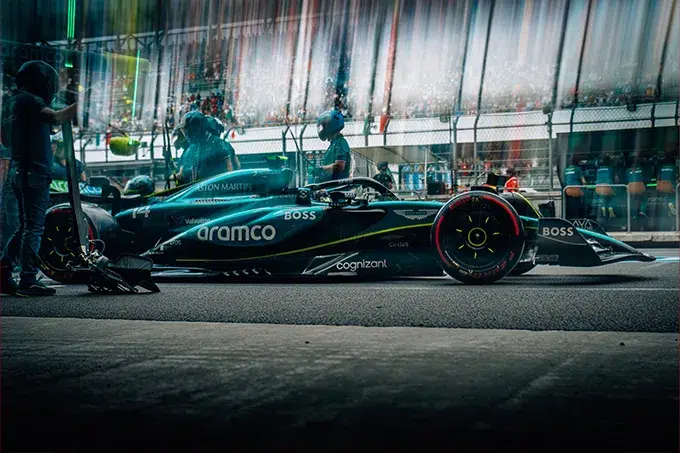Aston Martin F1 faces hard truths after Brazil, analyzing performance struggles and development missteps that derailed a promising season.
According to Fernando Alonso himself, Aston Martin F1 was arguably the slowest team in the Brazilian rain during the last Grand Prix.
Why such a fiasco, which placed Aston Martin F1 even behind the Saubers in race pace? Why do wet conditions further worsen the competitiveness of the green car, already underwhelming on dry tracks?
The settings and the floor design seem to be at fault (as with Lewis Hamilton’s case). After the two accidents involving Lance Stroll and Fernando Alonso in qualifying, Aston Martin F1 had to abandon its Japanese floor concept and revert to the Hungaroring setup, which is better suited to fast circuits. This change threw the entire AMR24 off balance, causing rear tire locking and significant bouncing.
Even without the drivers’ accidents, Aston Martin F1 had planned to continue evaluating the two floor types—a sign that the team may have lost its way in development during the second half of the season.
Tom McCullough, Performance Director, summed up this indecision between the parts:
“We have two main floor philosophies this year, and we’ve developed both depending on the tracks. The floor introduced in Austin aimed to combine the best of both worlds, with an experimental intent to prepare for next year.”
But the Austin floor failed to meet expectations, leading Aston to set it aside for Interlagos.
Fernando Alonso also suffered from severe bouncing during the Brazilian Grand Prix; without the dedication of the mechanics who repaired his car after his morning accident in qualifying, the Spaniard said he would have retired.
However, this floor change also contributed to Alonso’s bouncing issues. Due to FIA technical regulations, the team was required to change the floor without the ability to adjust the surrounding mechanical configuration, as suspension settings are locked in under parc fermé conditions.
Consequently, with an unsuitable floor and an extremely bumpy Interlagos circuit despite recent resurfacing, Fernando Alonso’s car was unbalanced and highly uncomfortable.
“It was clear that both drivers were struggling with an incredibly difficult car to drive during Sunday’s race,” confirms team principal Mike Krack.
“Our post-weekend analysis highlighted several factors explaining this. Following the qualifying accidents of both cars, we had to replace many components with a different specification due to availability at the end of a triple-header. This is permitted under Sprint event regulations, and you declare your shortages and replacement options to the FIA prior to the event.”
“But you are not allowed to change the mechanical settings of the cars. This meant we could neither check nor adjust the car settings, which negatively impacted aerodynamic behavior and performance.”
“Add to this wet and treacherous conditions along with an incredibly bumpy track, and it becomes clear that both drivers were in extremely unfavorable conditions. Both cars were particularly prone to wheel locking, and the data shows this is what caused the issues for Lance and Fernando.”
How to explain Aston Martin F1’s decline?
Tom McCullough, in charge of performance, mainly the area that has fallen short this year… How to explain Aston Martin F1’s struggles, even as it manages to save its fifth place in the constructors’ standings?
“Performance is relative. We haven’t made the progress we had hoped for this year.”
“This year, we didn’t make the progress we wanted, and our relative development against [other teams] wasn’t strong enough. That’s why we’ve struggled a bit more to score points on all types of circuits.”
Once again, Aston Martin F1 missed its mark with in-season development, even more so than in 2023. Will team principal Mike Krack acknowledge this?
“We’ve had our toughest season, as we didn’t meet our own expectations. Our goal was to develop a car capable of consistently competing with the top four, but we fell short. We need to accept this, learn from it, understand our mistakes, and determine how to move forward.”
Mike Krack offers an interesting perspective: Aston Martin F1 may have introduced too many upgrades, and too early.
“We might have been too quick to bring new parts to the track. Sometimes we were too hasty. The takeaway is clear: quality over quantity.”
“We need to accept the situation, extract the maximum lessons, understand the errors we made, and find the best way forward.”
“There’s a lot happening in the background that convinces me we’re heading in the right direction, which is why I’m confident.”
“We’re in a much better position than last year, having learned a great deal from both our successes and mistakes. We’re more meticulous and asking more questions to better align our expectations with our outcomes.”
On paper, Mike Krack has reason for optimism: Aston Martin F1 will soon have a new simulator, a new wind tunnel, and… Adrian Newey!

- Read also:
- KitKat Joins F1 as Official Chocolate Partner
- Stay up-to-date with the latest Formula 1 news by following us on Facebook and Twitter.
From Promise to Peril as Aston Martin F1’s Brazil GP Setbacks Unfold From Promise to Peril as Aston Martin F1’s Brazil GP Setbacks Unfold
